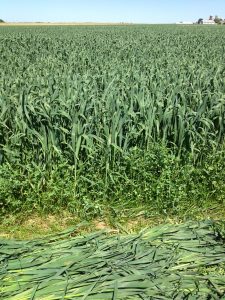David Hunsberger, Central Region Coordinator
With unusual weather this spring, we had more replant requests than normal, and learned some valuable lessons that can be applied next planting season and beyond.
The Mid-Atlantic region saw a very early warm up this spring, and it quickly turned cool and dry, but conditions became quite wet right before spring cereal harvest.
Alfalfa and Perennial forage seedlings:
The most common error we observed was poor seed to soil contact. Many growers were out early in the spring and in many cases hurried to put in the crop in before the weather changed. Often on conventionally tilled ground, the operator did not pack ahead of the Brillion or cultipacker seeder. Soil was dry and fluffy and there was often minimal catch and poor germination. Sometimes good emergence was evident only in tire tracks or hoof prints, where there had been enough compaction for adequate seed to soil contact. Sometimes the headlands or a narrow place that got multiple passes would have a much higher population.
During drier conditions, we need make sure to pack, pack, pack. In some cases that I observed the grower had packed with a roller but it was not effective. For very small seeds like perennial grasses and alfalfas, the soil surface should be firm enough that your foot print should not approach the depth of your boot sole, and you should be able to dribble a basketball or volleyball on the surface.
A related problem was failure to check planting depth of the seed drill, both in conventional and no-till systems. Seed that was planted too deep was more noticeable in stand failures than seed that was planted too shallow for early spring. On summer annuals, however, just the opposite was true. Dry, hard conditions prevented seeding at the proper depth, and shallow seedings were more likely to fail. (In these conditions, you are better off either adding more weight to the drill or just leaving the seed in the bag.)
 Poor alfalfa establishment was confirmed by many reports throughout Pennsylvania and New York. “The alfalfa germinated and emerged, then just seemed to stop growing,” said Marvin Hall, a forage agronomist at Penn State. “In some cases, six-week-old alfalfa was still in the unifoliate leaf stage. When temperatures warmed up, some of the plants grew out of it. Others just aren’t as thrifty as we would expect.” Timely plantings actually tended to get hit the hardest. The unifying factor in most of these poorly established stands was a timely planting hitting cold conditions and some late frost. In some cases plants were disappearing and some cases they were there but not growing. Many stands planted at a later date survived better.
Poor alfalfa establishment was confirmed by many reports throughout Pennsylvania and New York. “The alfalfa germinated and emerged, then just seemed to stop growing,” said Marvin Hall, a forage agronomist at Penn State. “In some cases, six-week-old alfalfa was still in the unifoliate leaf stage. When temperatures warmed up, some of the plants grew out of it. Others just aren’t as thrifty as we would expect.” Timely plantings actually tended to get hit the hardest. The unifying factor in most of these poorly established stands was a timely planting hitting cold conditions and some late frost. In some cases plants were disappearing and some cases they were there but not growing. Many stands planted at a later date survived better.
The second most common problem this year seemed to be the use of a winter annual to serve as a nurse crop. This year it behaved more like a smother crop as it outcompeted seedlings for sun and moisture. In addition to this scenario, I also saw terminated rye and triticale have a negative effect on subsequent seedings that may have been allelopathy or just smothering again as the old crop deteriorated. Tell tale signs of interference from the preceding small grain were good catches of the alfalfa stand in the spots where the small grain drill in the fall had a skipper. Where the small grain was absent the perennial forage seeding was robust and healthy. This practice of rotating a small grain into alfalfa may work in ideal growing conditions, but certainly not in a season like this past spring. We suggest a winter killed crop like oats as a better preparation for a spring seeding. Oats capture nutrients and protect the soil overwinter but be mostly decomposed by seeding time, and the soil will be mellow and ready to receive seed.
Freeze-outs/offs were another problem this year, as mentioned above, although it’s generally very uncommon for alfalfa to freeze in the spring. On spring-seeded stands that were already compromised by the above problems and went into spring cold snaps with already lower populations, surviving plants and subsequent germination flushes did not make up the loss and the total count was too low. Weeds quickly became a problem.
Cold, wet soils seemed to be the biggest reason behind failed stands. There was also a high incidence of poor slot closure and poor germination, and seed rotted in the furrow.
Slugs were prevalent in stand decimation. Bird predation was not widespread, but a problem in some areas. Blackbirds, robins, and grackles were the most problematic birds. We hear some anecdotal evidence from growers that Avipel is effective for bird predation.
Lastly, there were mechanical issues, including planter depth, seed spacing, and steep slopes in which the planter was lifted out of the ground to make it uphill. On these steep slopes planter performance suffered.
Speak to an expert at King’s AgriSeeds now at 1-717-687-6224 or email us at [email protected].
